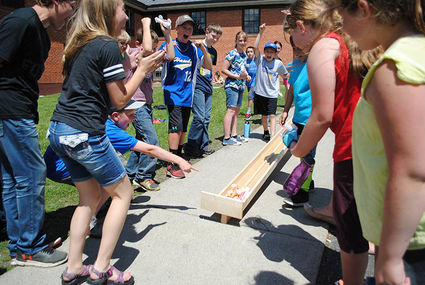Students design egg-cellent race cars
May 31, 2018

Justin Harris
PHOTO FINISH – Excitement couldn't be contained as the last heat concluded with drivers Callie McGillis and Mackenzie Robinson's egg cars hitting the finish line. The first place car belonged to Hattie Neesvig, who was absent that day.
It is an event that is becoming a year-end tradition for fifth and sixth grade students at Thompson Falls schools. A lesson in construction, velocity and impact results. A tournament of speed and design.
The Egg Car Races that took place Friday had students using only paper, glue, and tape to make car bodies, and plastic push-popsicle ends for wheels and axles. The idea was to create vehicles that could transport an egg down a wooden track with enough speed to beat their competitor and keep the egg from breaking. Rear-end, low weight loads proved most effective, and paper shreds of confetti were the most popular form of padding for the egg passengers in the vehicles.
The formula had a multitude of results for the 67 participants from the fifth and sixth grade - whether the car reached the end of the track or not. Few cars reached the finish and had an unbroken egg. Some reached the end only to have the egg hop out and break – or not break. There was more than one car that jumped the track only to hinder the opponent, and more often than not, the cars utilized the manual "three bump allowance" that had teacher Jase Miller getting down off his perch at the starting line to give struggling cars a nudge. As a general rule, if the car required a nudge to move, it would likely not reach the finish line and was disqualified.
"You could really tell who had done this last year and learned from design flaws," said Miller, who constructed an entirely new wooden track to facilitate the activity, only to find it would need a bit more angle to give cars a running start. Propped up by stacked chairs along the length of the track, Miller was posted at the top of a ladder to begin each heat. Teacher Sierra Lilly worked with other teachers to organize the bracket and fifth grade teacher Rebecka Turman called each new duo and their cars through a bullhorn (students were awfully patient standing in the sun awaiting their turn, but 'quiet' wasn't their forte). Teacher Jennifer Bowden, who had been working with the students on design in the days leading up to the event, wrangled participants and kept the track clear for optimal viewing for spectators.
Many fifth graders learned that their designs were too top-heavy, resulting in tipping cars and rolling eggs. Savvy sixth grade students remembered that a low-set egg would be best protected and give the car a lower center of gravity for accumulation of speed. "Some of the designs were very unrealistic, with holes too small to seat an egg or axles that were too short with wheels too close together," said Susan Jacobson, who had been an aide during the construction days, "but I think they'll remember their errors and apply their knowledge next year." That knowledge will be used against the up and coming class of wide eyed soon-to-be fifth grade students.
"It was kind of frustrating to build my car," said first-timer Elise Harris, "the paper kept crumpling and the egg would fall out, or the whole thing would collapse under the egg's weight. I've got some new ideas if I need to build one of these again though." Students lined the track throughout the event to cheer their peers on, and pointed out design positives and negatives to each other while waiting for their race.
The entire event lasted over an hour as heat after heat called students up with their cars in a single elimination bracket. The nail-biter heat named Hattie Neesvig the winner for the second consecutive year, with her sturdy design and free-rolling axle. Ironically, she was absent that day and had a fill-in driver for the competition. Callie McGillis and Mackenzie Robinson, substitute driver for Neesvig's car, accepted the first and second place trophies. There are improvements to the event each year. It was noted that a higher starting point would be needed and, likely, the shady side of the school building for a more comfortable experience.
Bowden worked with the sixth-grade students when construction began May 11.
She shared that there was a short track to test their prototypes on, along with a clay life-sized egg to allow for errors without a mess to clean up. Each student had to first come up with an engineering plan and design before construction. Troubleshooting took place right up until the event. "The kids were very egg-cited for the event," joked Bowden, "it is one of those fun, year-end things that help close out the school year with a bang." Or a splat, depending on the design.






Reader Comments(0)